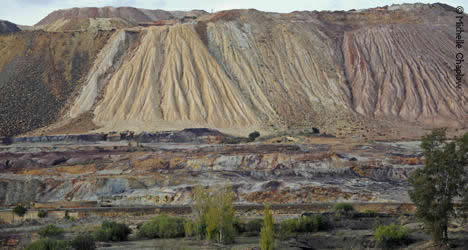
HISTORY of RIO TINTO MINES
By Chris Chaplow and Fiona Flores Watson
Rio Tinto mines are part of the 230km-Iberian pyrite belt, extending from Aznalcollar near Seville to Aljustrel in Portugal. Pyrite is a mineral containing a combination of Sulphur, iron and copper, with a metallic lustre which lends it the name "fool's gold". At certain points this mining field showed surface signs of two other vividly-coloured copper minerals, bright green malachite and deep blue azurite, which must have attracted the curiosity of the area's prehistoric inhabitants.
TARTESSANS
During the latter part of the Bronze Age (2,500 to 1,000 BC) the region was controlled by the Tartessans who probably mined silver at Rio Tinto.
Jewish history records in several places that gold and silver came from distant Tarshish (or Tharsis), a place so far away that the return voyage took the fleet three years. According to local myth, Rio Tinto are the fabled mines of King Solomon who ruled the tribes of Israel between 971 and 931 BC. Although one hill is still known as Cerro Salomón today, no proof exists that that Rio Tinto was the specific source.
The nearby villages of Zalamea La Vieja (now called Nerva) and Zalamea La Real may also be named after the biblical king. Equally they may be named after the Arabic 'salama' for peace and their origin probably dates from the Moorish period. Read more about Tartessos.
PHOENICIANS
The Phoenicians were merchants who founded Cadiz in 1100BC and with whom the Tartessans traded. They certainly mined silver after 800BC at Rio Tinto and according to classical historian Diodorus Siculus, when their ships were freighted to the full, they threw away their anchors and substituted new ones of silver.
In the village of Alosno (sic), where the mines of Tharsis are located, now another village called Tharsis, the residents believe that they are descended from Phoenicians. Another claim is that their strange and beautiful music, the esquila of Rio Tinto (poems accompanied by music played on stringed instruments), have an eastern origin.
Archaeologists Dr A Blanco, Dr J M Luzon and Dr D Ruiz from Seville University found an eighth century BC Phoenician village on the slopes of Cerro Salomon. The small houses had undressed stone walls and mud floors, with entrances protected on the outside by projecting walls, a detail not previously found in Iberia but common in the near east. The slag left from smelting was found scattered throughout the houses together with charcoal and drops of lead, mixed with pottery and bones, showing that for these early Huelvan residents, metal founding was a domestic activity.
Silver, not copper, had been extracted, by digging small holes in the ground, lining them with clay and filling them with pulverized ore, and adding a silica flux and charcoal which was ignited. Then air from primitive bellows was forced down a clay pipe to near the bottom of the bowl-furnace until the contents melted. On cooling, the lead and the silver in the ore formed an ingot underneath the slag and the two metals were separated by a process of "cupellation" (primitive refining using a cupel, or funnel) in which the ingot was melted and the lead contents oxidized, leaving the pure silver in its natural state. The origins of this process, as deduced by Blanco and Luzon, is unknown but it does testify to their advanced technology.
The Phoenician contact with Tartessos seemed to have suffered as a result of Nebuchadnezzar's 13-year siege of Tyre in 580 BC. They were replaced by the Phoceans (from Ionian Greece) who traded wine and olives (the first introduction of these products to Iberia) for silver and other local metals.
Carthaginians
The Phoenicians were defeated in battle by the Carthaginians in 535BC, who set about building their own empire and destroyed the city of Tartessos.
Then the Carthaginians were defeated by the Romans in 205 BC. More >
Romans
Read more about History of Rio Tinto Mines - Romans
Thanks to David Avery and RTZ for their 1974 book Not on Queen Victoria's Birthday, which is the definitive history of the Rio Tinto Mines. Thanks to William Giles Nash for his 1910 book The Rio Tinto Mine: Its History And Romance,from which much of this information was sourced.
Buy your copy of Not on Queen Victoria's Birthday
 Not on Queen Victoria's Birthday: Story of the Rio Tinto Mines by David Avery
Not on Queen Victoria's Birthday: Story of the Rio Tinto Mines by David Avery
The story of Rio Tinto Zinc is in no small part the story of Britian imperialism. In the last hundred years of the British Empire, Rio Tinto grew massively, as its miners and engineers discovered lucrative mineral deposits throughout the empire. An interesting look at a little-covered aspect. But one that provided the raw materials for much of Britain's needs. Albeit at often exploitive cost to the native peoples around the mines.
What might be a little suprising is how Rio Tinto survived the implosion of the empire, and the rise of newly independent nations, several of which wanted their mining rights returned. But Rio Tinto had the technology and skilled personnel that helped it navigate decolonisation. As well as access to the markets of the developed nations.
Buy from Amazon.co.uk or Amazon.es